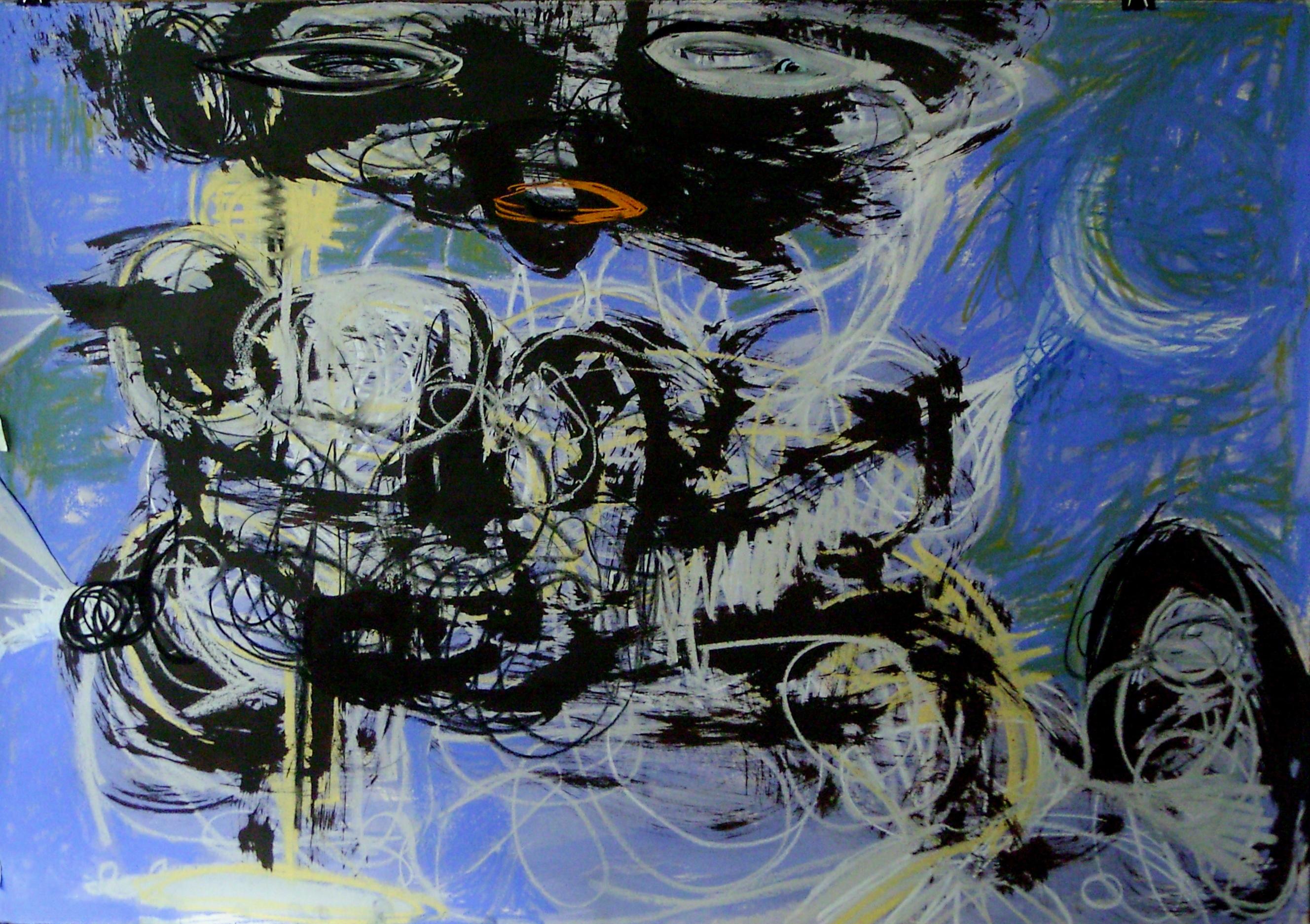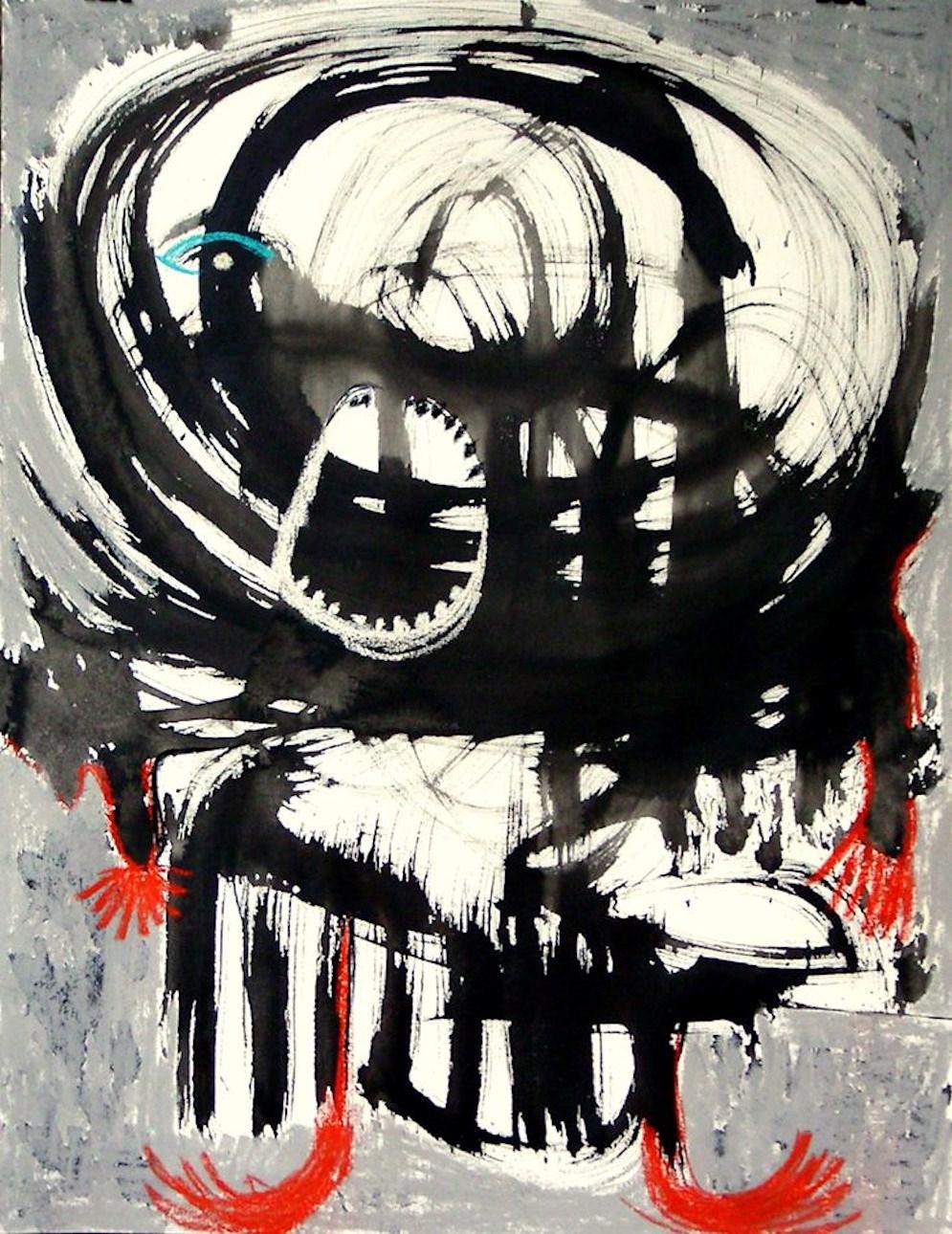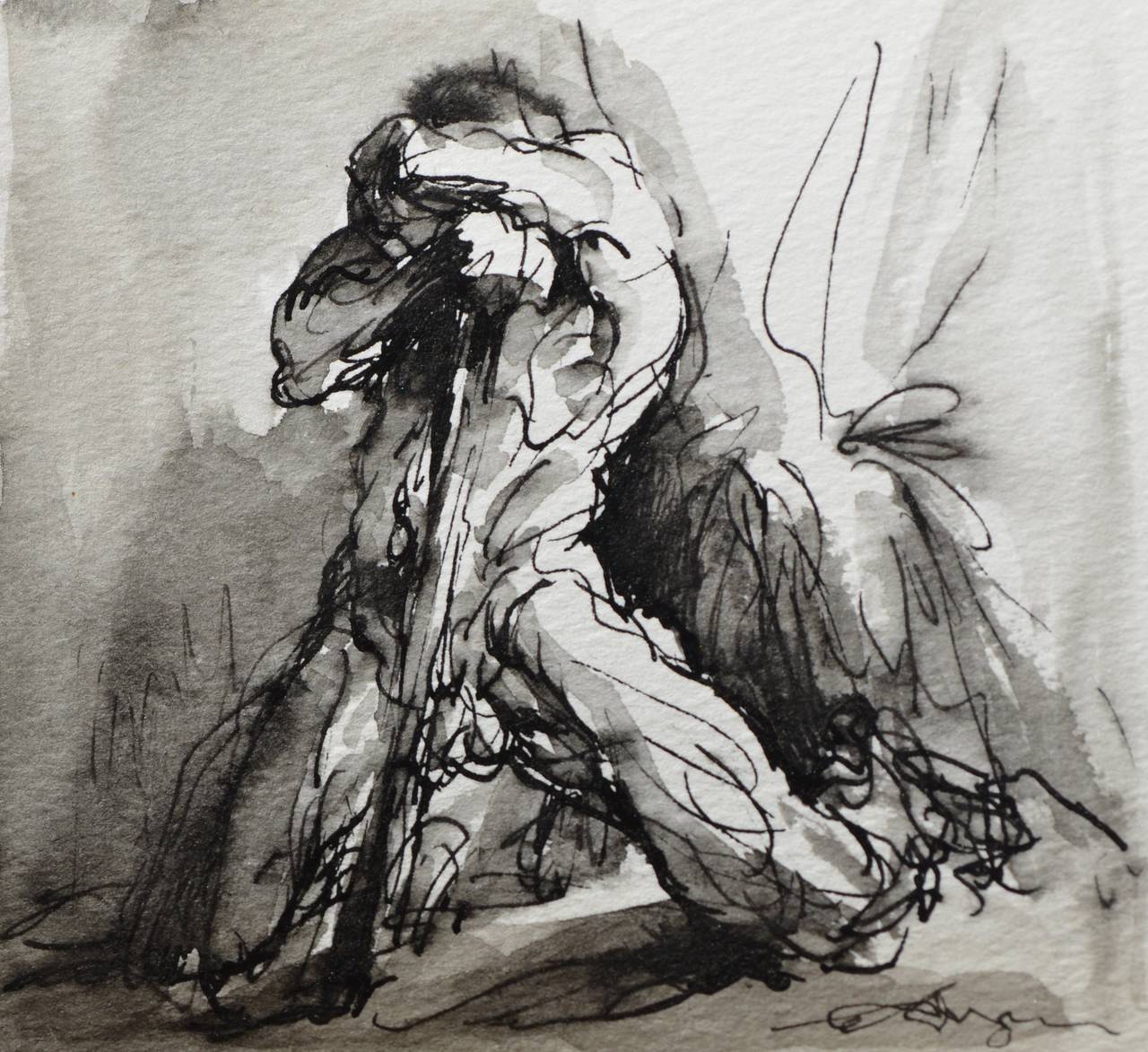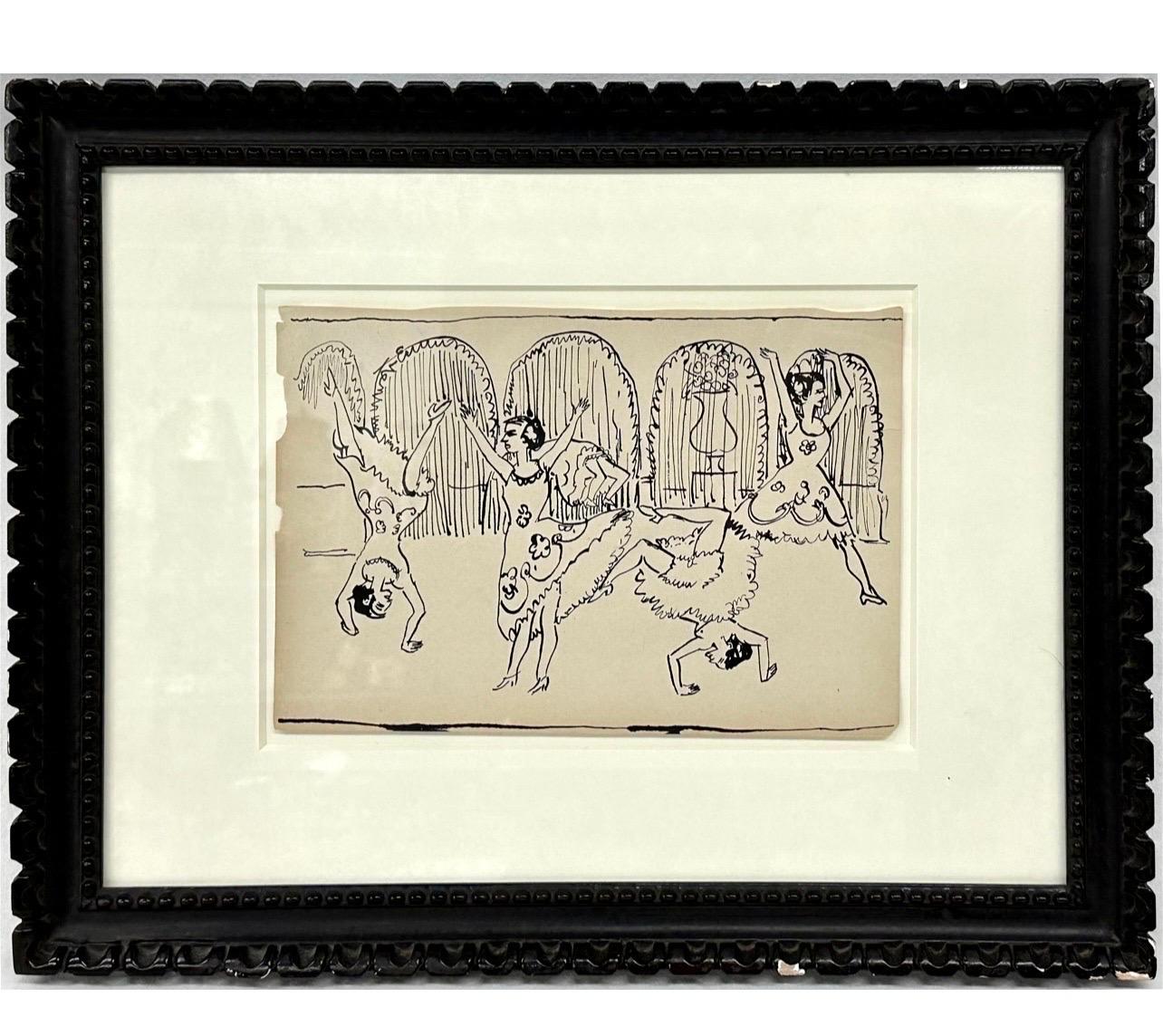Items Similar to Seated Woman
Want more images or videos?
Request additional images or videos from the seller
1 of 10
Jules PascinSeated WomanUnkown
Unkown
About the Item
Seated Woman by Jules Pascin (1885-1930)
Pen and ink on paper
6 ½ x 6 inches unframed (16.51 x 15.24 cm)
14 x 13 inches framed (35.56 x 33.02 cm)
Inscribed (Pascin Estate 81C) on bottom right
Stamped with estate stamp on bottom right
Description:
Jules Pascin was a Bulgarian painter who, contrary to his American citizenship, found his primary audience and success in Paris during the early twentieth century. In his early life, he frequently moved through Europe and America (particularly the South) before gaining citizenship in the United States and returning to Paris.
He is best known for his drawings of women, often of prostitutes. This interest in the female body, particularly a non-posed and candid one, carried through his entire artistic career. His practice focused particularly on this female body as a means for evoking character, personality, and emotion apart from the face.
Such an emphasis is well exemplified in "Seated Woman," within which Pascin holistically represents a woman in a seated position, with more emphasis paid to the folds of her clothes and her posture than her face. Pascin is often considered central to the emerging Paris art scene in the 1900s and was revered in his lifetime for his eccentric, esoteric persona and artwork.
- Creator:Jules Pascin (1885-1930, Bulgarian, French)
- Creation Year:Unkown
- Dimensions:Height: 6.75 in (17.15 cm)Width: 6 in (15.24 cm)
- Medium:
- Movement & Style:
- Period:
- Condition:
- Gallery Location:New York, NY
- Reference Number:1stDibs: LU1637210376992
About the Seller
5.0
Vetted Seller
These experienced sellers undergo a comprehensive evaluation by our team of in-house experts.
Established in 1948
1stDibs seller since 2021
7 sales on 1stDibs
Typical response time: 2 hours
- ShippingRetrieving quote...Ships From: New York, NY
- Return PolicyA return for this item may be initiated within 14 days of delivery.
More From This SellerView All
- Padua near VeniceBy Max WeberLocated in New York, NYEquestrian Statue by Donatello- Padua near Venice, 1907, by Max Weber (1881-1961) Ink wash and blue chalk on paper 4 x 5 inches unframed (10.16 x 12.7 cm) 10 ¾ x 12 ⅞ inches framed...Category
Early 20th Century Post-Modern Figurative Drawings and Watercolors
MaterialsInk, Chalk
- Study for Sculpture of Nude Woman Balancing BabyBy Chaim GrossLocated in New York, NYStudy for Sculpture of Nude Woman Balancing Baby, 1949, by Chaim Gross (1902-1991) Ink on paper 10 ½ x 7 ½ inches unframed (26.67 x 19.05 cm) 1...Category
1940s Modern Figurative Drawings and Watercolors
MaterialsPaper, Ink, Pen
- Figural StudyBy Chaim GrossLocated in New York, NYFigural Study, ca. 1949-1959, by Chaim Gross (1902-1991) Ink on fabric 18 x 16 ¼ inches (45.72 x 41.275 cm) 25 x 23 ⅝ inches (63.5 x 60.0075 cm) Inscribed...Category
Mid-20th Century Modern Figurative Drawings and Watercolors
MaterialsInk
- Happy BirthdayBy Chaim GrossLocated in New York, NYHappy Birthday, 1950, by Chaim Gross (1902-1991) Ink on paper 5 ¼ x 4 inches unframed (13.335 x 10.16 cm) 11 ¼ x 10 ⅛ inches framed (28.575 x 25.7175 cm...Category
Mid-20th Century Modern Figurative Drawings and Watercolors
MaterialsInk
- Two Seated MenBy Henri LebasqueLocated in New York, NY“Two Seated Men” by Henri Lebasque (1865-1937) Pencil and watercolor on paper 6 x 5 inches unframed (15.24 x 12.7 cm) Signed on bottom right Description: In ...Category
20th Century Figurative Drawings and Watercolors
MaterialsPencil, Watercolor
- Seated Feminine FigureBy Reuven RubinLocated in New York, NYSeated Feminine Figure by Reuven Rubin (1893-1974) Pencil on paper 7 ½ x 7 ¾ inches unframed (19.05 x 19.685 cm) 14 x 14 inches framed (35.56 x 35.56 ...Category
20th Century Figurative Drawings and Watercolors
MaterialsPencil
You May Also Like
- The Moonslayer - Parmis Sayous 21st Century drawing Iranian contemporary painterBy Parmis SayousLocated in Paris, FRPastel and India ink on cardboard Created in 2019 in Paris, France Unique work Signed by the artist Parmis Sayous was born in 1982 in Teheran, Iran. Since 2015, She has lived and wo...Category
2010s Expressionist Figurative Drawings and Watercolors
MaterialsPastel, India Ink, Cardboard
- Untitled - Parmis Sayous 21st Century drawing, Iranian contemporary painterBy Parmis SayousLocated in Paris, FRInk and pastel on canvas Created in 2019 in Paris, France Unique work Signed by the artist Parmis Sayous was born in 1982 in Teheran, Iran. Since 2015, She has lived and worked in P...Category
2010s Expressionist Figurative Drawings and Watercolors
MaterialsCanvas, Pastel, Ink
- Planting the StakeBy Gustav RehbergerLocated in West Hollywood, CAWe are proud to present a just arrived series of original pen and ink and ink wash drawings by Austrian/American artist Gustav Rehberger. These works were acquired directly from the ...Category
1970s Expressionist Figurative Drawings and Watercolors
MaterialsInk
- Original German Expressionist Drawing Ernst Ludwig Kirchner Women DancingBy Ernst Ludwig KirchnerLocated in Surfside, FLErnst Ludwig Kirchner ( Germany 1880-1938 ) Expressionist Female Women Dancing Mixed Media on Paper Drawing or Painting Expressionism Dimensions: 20" L 16" H in This bore a sticker from Christies auction house and another collection sticker verso but they have been inadvertently removed. I do have the photo. Ernst Ludwig Kirchner (1880 – 1938) was a German expressionist painter and printmaker and one of the founders of the artists group Die Brücke or "The Bridge", a key group leading to the foundation of Expressionism in 20th-century art. He volunteered for army service in the First World War, but soon suffered a breakdown and was discharged. His work was branded as "Entartete Kunst" or "degenerate" by the Nazis in 1933, and in 1937 more than 600 of his works were sold or destroyed. Ernst Ludwig Kirchner was born in Aschaffenburg, Bavaria. His parents were of Prussian descent and his mother was a descendant of the Huguenots, a fact to which Kirchner often referred. As Kirchner's father searched for a job, the family moved frequently and Kirchner attended schools in Frankfurt and Perlen until his father earned the position of Professor of Paper Sciences at the College of technology in Chemnitz, where Kirchner attended secondary school. Although Kirchner's parents encouraged his artistic career they also wanted him to complete his formal education so in 1901, he began studying architecture at the Königliche Technische Hochschule (royal technical university) of Dresden. The institution provided a wide range of studies in addition to architecture, such as freehand drawing, perspective drawing and the historical study of art. While in attendance, he became close friends with Fritz Bleyl, whom Kirchner met during the first term. They discussed art together and also studied nature, having a radical outlook in common. Kirchner continued studies in Munich from 1903 to 1904, returning to Dresden in 1905 to complete his degree. In 1905, Kirchner, along with Bleyl and two other architecture students, Karl Schmidt-Rottluff and Erich Heckel, founded the artists group Die Brücke ("The Bridge") later to include Emil Nolde, Max Pechstein and Otto Mueller. From then on, he committed himself to art. The group aimed to eschew the prevalent traditional academic style and find a new mode of artistic expression, which would form a bridge (hence the name) between the past and the present. They responded both to past artists such as Albrecht Dürer, Matthias Grünewald and Lucas Cranach the Elder, as well as contemporary international avant-garde movements. As part of the affirmation of their national heritage, they revived older media, particularly woodcut or woodblock prints. Kirchner's studio became a venue which overthrew social conventions to allow casual love-making and frequent nudity. Group life-drawing sessions took place using nude models from the social circle, rather than professionals, and choosing quarter-hour poses to encourage spontaneity. In 1911, he moved to Berlin, where he founded a private art school, MIUM-Institut, in collaboration with Max Pechstein with the aim of promulgating "Moderner Unterricht im Malen" (modern teaching of painting). This was not a success and closed the following year, when he also began a relationship with Erna Schilling that lasted the rest of his life. In 1917, at the suggestion of Eberhard Grisebach [de], Helene Spengler invited Kirchner to Davos where he viewed an exhibition of Ferdinand Hodler paintings. "When I was leaving, I thought of Vincent Van Gogh's fate and thought that it would be his as well, sooner or later. Only later will people understand and see how much he has contributed to painting". In 1921 Kirchner visited Zurich at the beginning of May and met the dancer, Nina Hard, whom he invited back to Frauenkirch (despite Erna's objections). Nina Hard would become an important model for Kirchner and would be featured in many of his works. Kirchner began creating designs for carpets which were then woven by Lise Gujer. In 1925, Kirchner became close friends with fellow artist, Albert Müller...Category
Early 20th Century Expressionist Figurative Drawings and Watercolors
MaterialsInk, Paper
- Expressionist Color Drawing Cobalt Glass Vintage Frame Modernist Ben Zion WPABy Ben-Zion WeinmanLocated in Surfside, FLExpressionist ink and pastel crayon drawing of flowers in vase. Framed in a vintage cobalt blue glass original frame Hand signed and dated Framed it measures 13.5 X 10.5 The actual paper is 7.5 X 5.5 Born in 1897, Ben-Zion Weinman celebrated his European Jewish heritage in his visual works as a sculptor, painter, and printmaker. Influenced by Spinoza, Knut Hamsun, and Wladyslaw Reymont, as well as Hebrew literature, Ben-Zion wrote poetry and essays that, like his visual work, attempt to reveal the deep “connection between man and the divine, and between man and earth.” An emigrant from the Ukraine, he came to the US in 1920. He wrote fairy tales and poems in Hebrew under the name Benzion Weinman, but when he began painting he dropped his last name and hyphenated his first, saying an artist needed only one name. Ben-Zion was a founding member of “The Ten: An Independent Group” The Ten” a 1930’s avant-garde group, Painted on anything handy. Ben-Zion often used cabinet doors (panels) in his work. Other members of group included Ilya Bolotowsky, Lee Gatch, Adolph Gottlieb, Louis Harris, Yankel Kufeld, Marcus Rothkowitz (later known as Mark Rothko), Louis Schanker, and Joseph Solman. The Art of “The Ten” was generally described as expressionist, as this style offered the best link between modernism and social art. Their exhibition at the Mercury Gallery in New York held at the same time as the Whitney Annual Exhibition of Contemporary American Painting, included a manifesto concentrating on aesthetic questions and criticisms of the conservative definition of modern art imposed by the Whitney. Ben-Zion’s work was quickly noticed. The New York Sun said he painted “furiously” and called him “the farthest along of the lot.” And the triptych, “The Glory of War,” was described by Art News as “resounding.” By 1939, The Ten disbanded because most of the members found individual galleries to represent their work. Ben-Zion had his first one-man show at the Artist’s Gallery in Greenwich Village and J.B. Neumann, the highly esteemed European art dealer who introduced Paul Klee, (among others) to America, purchased several of Ben-Zion’s drawings. Curt Valentin, another well-known dealer, exhibited groups of his drawings and undertook the printing of four portfolios of etchings, each composed of Ben-Zion’s biblical themes. He worked as a WPA artist. Ben-Zion’s work is represented in many museums throughout the country including the Metropolitan, the Whitney, and the Museum of Modern Art in New York, the Art Institute of Chicago, the Philadelphia Museum of Art and the Phillips Collection, Washington. The Jewish Museum in New York opened in 1948 with a Ben-Zion exhibition. Ben-Zion consistently threaded certain subject matter—nature, still life, the human figure, the Hebrew Bible, and the Jewish people—into his work throughout his life. "In all his work a profound human feeling remains. Sea and sky, even sheaves of wheat acquire a monolithic beauty and simplicity which delineates the transient as a reflection of the eternal. This sensitive inter- mingling of the physical and metaphysical is one of the most enduring features of Ben-Zion's works." (Excerpt from Stephen Kayser, “Biblical Paintings,” The Jewish Museum Catalogue, 1952). Mystical Imprints: Marc Chagall, Ben-Zion, and Ben Shahn presents the print work of three prominent 20th century Jewish artists born in the Russian Empire. Among these seventy pieces are etchings and lithographs from Chagall’s Bible series...Category
1950s Expressionist Still-life Drawings and Watercolors
MaterialsPaper, Oil Crayon, Pastel, Ink
- Expressionist Miniature Drawing Wheat Stalks American Modernist Ben Zion WPABy Ben-Zion WeinmanLocated in Surfside, FLExpressionist ink drawing of wheat stalks There is an inscription "Happy New Year" on verso Hand signed Framed it measures 7.75 X 5.75 The actual paper is 3 X 3.5 Born in 1897, Ben-Zion Weinman celebrated his European Jewish heritage in his visual works as a sculptor, painter, and printmaker. Influenced by Spinoza, Knut Hamsun, and Wladyslaw Reymont, as well as Hebrew literature, Ben-Zion wrote poetry and essays that, like his visual work, attempt to reveal the deep “connection between man and the divine, and between man and earth.” An emigrant from the Ukraine, he came to the US in 1920. He wrote fairy tales and poems in Hebrew under the name Benzion Weinman, but when he began painting he dropped his last name and hyphenated his first, saying an artist needed only one name. Ben-Zion was a founding member of “The Ten: An Independent Group” The Ten” a 1930’s avant-garde group, Painted on anything handy. Ben-Zion often used cabinet doors (panels) in his work. Other members of group included Ilya Bolotowsky, Lee Gatch, Adolph Gottlieb, Louis Harris, Yankel Kufeld, Marcus Rothkowitz (later known as Mark Rothko), Louis Schanker, and Joseph Solman. The Art of “The Ten” was generally described as expressionist, as this style offered the best link between modernism and social art. Their exhibition at the Mercury Gallery in New York held at the same time as the Whitney Annual Exhibition of Contemporary American Painting, included a manifesto concentrating on aesthetic questions and criticisms of the conservative definition of modern art imposed by the Whitney. Ben-Zion’s work was quickly noticed. The New York Sun said he painted “furiously” and called him “the farthest along of the lot.” And the triptych, “The Glory of War,” was described by Art News as “resounding.” By 1939, The Ten disbanded because most of the members found individual galleries to represent their work. Ben-Zion had his first one-man show at the Artist’s Gallery in Greenwich Village and J.B. Neumann, the highly esteemed European art dealer who introduced Paul Klee, (among others) to America, purchased several of Ben-Zion’s drawings. Curt Valentin, another well-known dealer, exhibited groups of his drawings and undertook the printing of four portfolios of etchings, each composed of Ben-Zion’s biblical themes. He worked as a WPA artist. Ben-Zion’s work is represented in many museums throughout the country including the Metropolitan, the Whitney, and the Museum of Modern Art in New York, the Art Institute of Chicago, the Philadelphia Museum of Art and the Phillips Collection, Washington. The Jewish Museum in New York opened in 1948 with a Ben-Zion exhibition. Ben-Zion consistently threaded certain subject matter—nature, still life, the human figure, the Hebrew Bible, and the Jewish people—into his work throughout his life. "In all his work a profound human feeling remains. Sea and sky, even sheaves of wheat acquire a monolithic beauty and simplicity which delineates the transient as a reflection of the eternal. This sensitive inter- mingling of the physical and metaphysical is one of the most enduring features of Ben-Zion's works." (Excerpt from Stephen Kayser, “Biblical Paintings,” The Jewish Museum Catalogue, 1952). Mystical Imprints: Marc Chagall, Ben-Zion, and Ben Shahn presents the print work of three prominent 20th century Jewish artists born in the Russian Empire. Among these seventy pieces are etchings and lithographs from Chagall’s Bible series...Category
1950s Expressionist Still-life Drawings and Watercolors
MaterialsInk
Recently Viewed
View AllMore Ways To Browse
Greco Roman Mural
William Hogarth On Sale
Hermes Chicago Il
Hermes In Nashville
Hermes Nashville Tn
Hermes Nashville
Hermes Near New York Ny
Hermes Party Nyc
Hubert Buel
Hugh Steers
Jack Leonard Shadbolt
Jacob Aronson
Jan Pieter Verdussen Garden Flowers
Jan Szczepkowski On Sale
Jane Wrightsman
Jayne Foster
Jean-Charles Lauthe On Sale
Jean Leon Gerome Ferris On Sale





